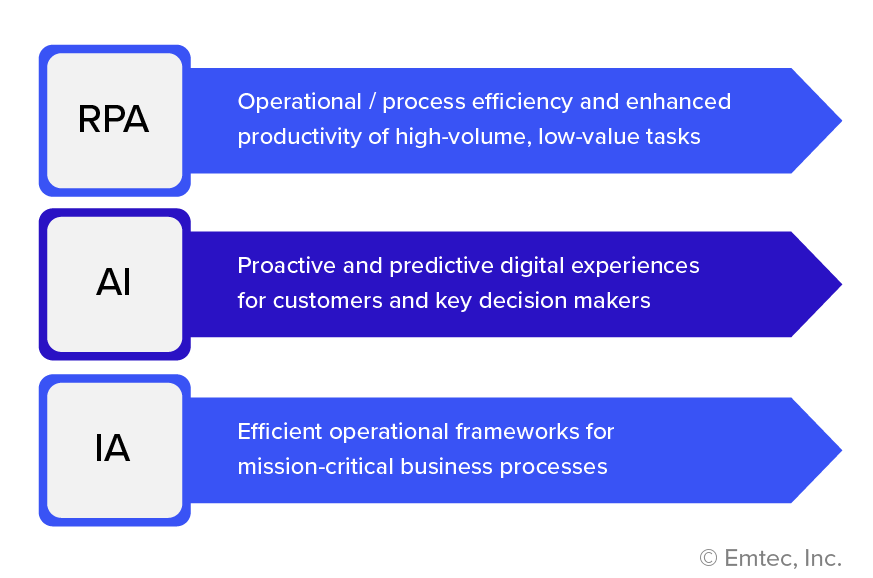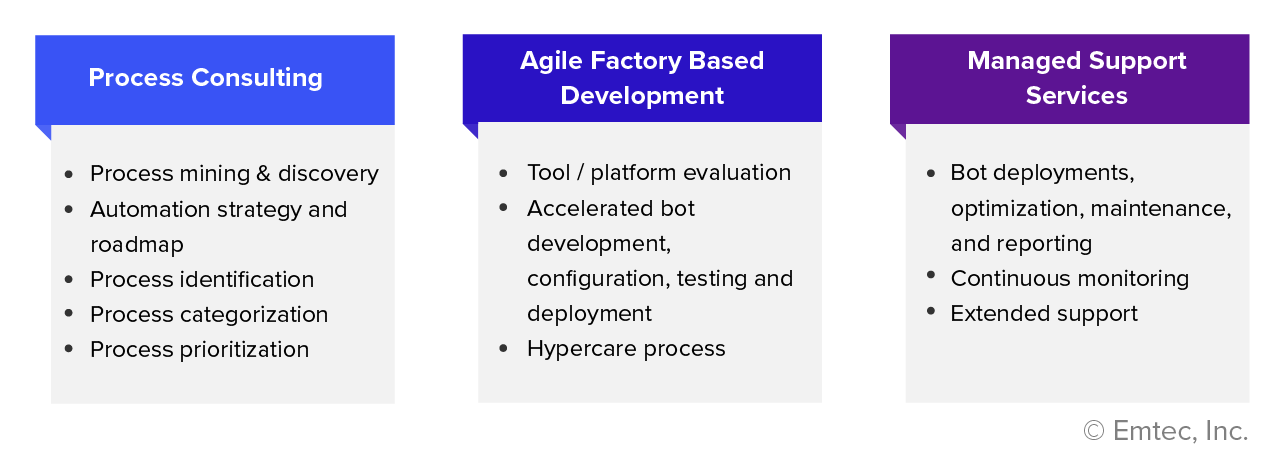It’s the era of rapid digitalization and organizations are riding the transformation wave with enhanced speed and dexterity. Robotic Process Automation (RPA) is the most obvious choice when it comes to dealing with mundane, repetitive, and rule-based tasks that eat up both resource effort and processing time. RPA has witnessed massive adoption in the last few years with organizations pumping in huge amounts of money to digitize day-to-day activities.
Global RPA software revenue projected to reach $1.89 Billion in 2021, an increase of 19.5% from 2020
~~~ Gartner
RPA software spending to total $2.4 Billion in 2022
~~~ Gartner
This leaves us with the question – is RPA alone enough to drive sustained digital transformation? Though RPA provides an incredible value proposition to enterprises, the path to Cognitive RPA (RPA 4.0) demands seamless integration with intelligent technologies such as Artificial Intelligence (AI) and Machine Learning (ML). For enterprise digital transformation to take off systematically and with speed, it is important to integrate RPA and intelligent technologies into your business strategy roadmap.
Around 28% enterprises implementing and scaling RPA are also implementing cognitive automation
~~~ Deloitte Global RPA Survey
Intelligent RPA can bridge operational gaps between multiple disparate enterprise legacy systems to accelerate ROI. It is also a critical enabler of sustained transformation and one step closer to the adoption of advanced and emerging technologies such as deep learning, computer vision, natural language processing, and cognitive computing.
| Maximizing ROI with intelligent automation |
| A global financial leader achieved a whopping 1300% ROI by combining human intelligence, machine power, and cognitive capabilities to automate hundreds of routine back office processes |
Automation first – if there’s any chance you can automate, you should
Automation has become the core of organizational digital transformation initiatives – yet the gains fail to measure up. So, what are organizations doing wrong? Well, we can say with conviction that it’s not about technology adoption as much as it is about the overall approach to the transformation. Consider this – we are living in a century where devices speak to each other (the Internet of Things); data is exploding beyond measure so much so that silos cannot contain this information any longer; the power of on-demand cloud computing is creating immersive and next-gen digital experiences. It’s high time organizations took an “automation first” approach to digital transformation.
What exactly is an automation first approach? Does automation first imply people second? Far from it. An automation first mindset ensures human talent is freed from routine, complex, time-consuming tasks to focus on more strategy-oriented activities. Activities that are essential to resolve challenges standing in the way of sustained business growth. Unlike traditional processes, an automation-centric approach begins with automation and answers one simple question – what are the tasks that can be automated and don’t require human intervention? This not only widens the scope of activities that can be automated; it also sets off a spark of innovation allowing businesses to think big and outside of the box. An automation first mindset strategizes new solution design and deployment and drives continuous process improvements through tools refinement.
| Accelerating business transformation with RPA |
| A leading IT consulting firm witnessed a 50% increase in productivity with ZERO errors by deploying a fully automated solution supported by a digital workforce (software robots) |
The dawn of the intelligent digital enterprise
Today, it’s not enough to be a digital enterprise – only an intelligent digital enterprise will emerge successful. Participants of the new intelligence revolution will survive in this disruptive age; those that fail to embrace RPA, AI, ML, and Intelligent Automation (IA) will fall away without a trace.
More than 45% digitally mature organizations have implemented a clearly articulated AI strategy
~~~ Adobe
Organizations that have intelligently matured digitally often have multiple workforce layers comprising humans and machines enabled by advanced technology for speedy execution of tasks. To accomplish this, it is essential to build a strategic roadmap that factors in the digital disruption likely to impact key pillars of the business such as organizational culture, day-to-day operations, and solution delivery.

Top-down RPA or bottom-up RPA?
Enterprise-level automation can either be top-down or bottom-up across three levels – task automation, process automation, and organization-wide automation. A top-down approach borders on the automation first mindset, requiring total C-level buy-in to implement automation at the organizational level for business transformation. While top-down is unarguably the best way to go, it is important to consider that most automation happens at the individual task and process level. This is where a bottom-up approach will be more beneficial. A bottom-up approach also eliminates “automation anxiety”, enabling organizations to progress steadily on their digital transformation journey. To strike a good balance between both approaches, it is important to ensure technological compatibility across the three levels of automation. Enterprise-wide automation needs to be agile and scalable with magnified automation orchestration capabilities, while retaining its simplicity and algorithm integration capacity. Successful implementation of enterprise-wide automation is possible by striking a balance between the top-down and bottom-up initiatives leading to sustained automation at all levels.
The necessary hype around hyperautomation
The IT industry is famous for coining new phrases; but the fact that Gartner includes hyperautomation as one of the top 10 strategic technology trends for 2020 makes it worthy of mention. Hyperautomation is basically “automation on steroids” – an amalgamation of intelligent tools (RPA, AI, ML) supported by a very powerful AI-driven decision-making strategy. Hyperautomation is key to scaling a speedy and efficient automation first approach and brings together disruptive technologies for end-to-end automation. Hyperautomation is the first step towards creating a digital twin that enables enterprises to visualize the interaction and performance of disparate functions and processes within the organization.
| Achieving audit compliance with process automation |
| Top home appliances manufacturer gained 70% improvement in productivity with over 50% reduction in TCO and further achieved audit compliance by automating critical enterprise processes |
Any mention of hyperautomation wouldn’t be complete without highlighting the importance of democratization of RPA. In simple terms, RPA democratization is about facilitating easy accessibility to automation tools and skills for everyone in the organization. Democratization enables smooth and efficient operations; builds productive and happy teams; and creates superior customer experiences – leading to overall business success.
By 2024, organizations will lower operational costs by 30% by combining hyperautomation technologies with redesigned operational processes ~~~ Gartner
Why a Robotics Center of Excellence (CoE) should be at the heart of your intelligent RPA initiatives
Top-down RPA deployments involve acquiring a centralized view of the business to identify high-volume, high-value, and time-consuming processes. This can be easily achieved by building a dedicated Center of Excellence (CoE). The CoE not only manages high-impact processes, but also establishes standard governance models that adhere to RPA best practices and policies for automating day-to-day processes through the bottom-up approach. A CoE is a unified approach to scale enterprise-wide automation and offers several key benefits.
- Accelerated ROI from RPA implementations
- More accountable, centralized teams
- Efficient operations
- Increased productivity
- Good governance
- Enhanced security
An experienced implementation partner makes all the difference
With RPA implementations becoming mainstream, it can be a daunting task to identify the right partner who can provide a consultative approach to automating your business processes. While the market is full of vendors dabbling in RPA and intelligent automation, the following parameters are worth considering while selecting the right partner –
- Impeccable RPA portfolio
- Implementation speed
- Platform scalability
- Robust reporting tools and methodologies
- Capabilities in technology and design innovation
- Failsafe data security and compliance protocols
- Delivery excellence
- Dedicated CoE
End-to-end RPA solutions from Emtec Digital
Emtec Digital’s comprehensive RPA consulting and agile development services help organizations maximize the ROI on their automation initiatives. Backed by robust standards and governance models, we offer focused RPA solutions across the intelligent automation spectrum.

Contact us today to learn how we can help you drive sustained digital transformation through structured RPA initiatives.




